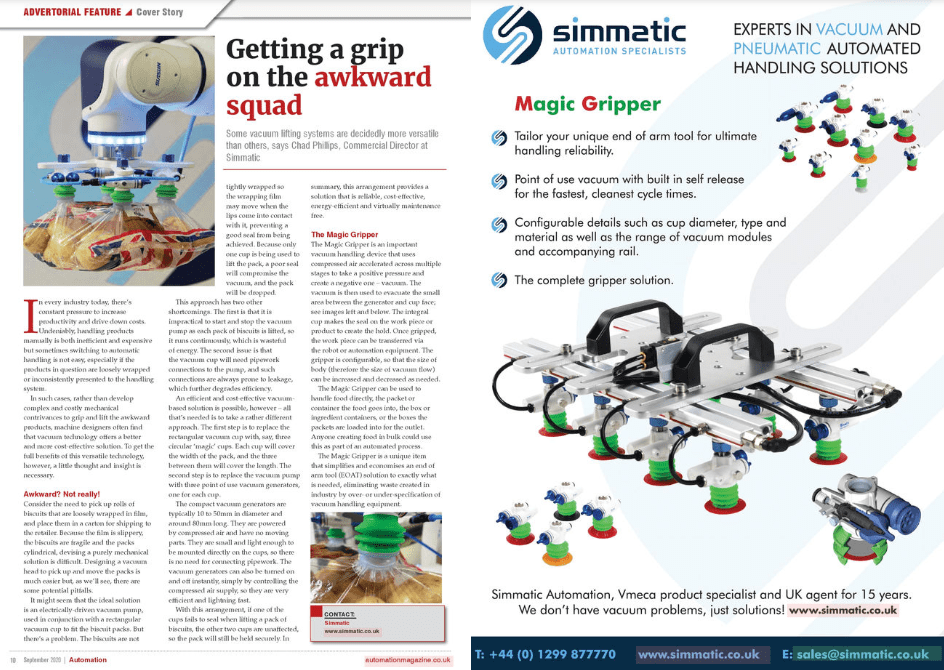
When it comes to gripping and handling irregularly shaped or loosely wrapped produces, vacuum lifting is often the only viable solution. But some vacuum lifting systems are decidedly more versatile than others, as Dale Simmonds, Managing Director of Simmatic, explains.
In every industry today, there’s constant pressure to increase productivity and drive down costs. Undeniably, handling products manually is both inefficient and expensive but sometimes switching to automatic handling is no easy task, especially if the products in question are loosely wrapped or inconsistently presented to the handling system.
In such cases, rather than develop complex and costly mechanical contrivances to grip and lift the “awkward” products, machine designers often find that vacuum gripper technology offers a better and more cost-effective solution. To get the full benefits of this versatile technology, however, a little thought and insight is necessary.
Consider, for example, a machine that needs to pick up rolls of biscuits that are loosely wrapped in film, and place them in a carton for shipping to the retailer. Because the film is slippery, the biscuits are fragile and the packs are cylindrical, devising a purely mechanical solution is difficult. Designing a vacuum head to pick up and move the packs is much easier but, as we’ll see, there are some potential pitfalls.
It might seem that the ideal solution is an electrically driven vacuum pump, used in conjunction with a rectangular vacuum cup with flexible lips dimensioned to fit the biscuit packs. But there’s a problem. The biscuits are not tightly wrapped so the wrapping film may move a little when the lips come into contact with it, preventing a good seal from being achieved. Because only one cup is being used to lift the pack, a poor seal will probably destroy the vacuum, and the pack will be dropped.
This approach has two other shortcomings. The first is that it’s impractical to start and stop the vacuum pump as each pack of biscuits is lifted, so it must run continuously, which is wasteful of energy. The second issue is that the vacuum cup will need pipework connections to the pump, and such connections are always prone to leakage, which further degrades efficiency.
An efficient and cost-effective vacuum-based solution is possible, however – all that’s needed is to take a rather different approach. The first step is to replace the single rectangular vacuum cup with, say, three standard circular cups. Each cup will cover the width of the pack, and the three between them will cover the length. The second step is to replace the vacuum pump with three separate vacuum generators – one for each cup.
The vacuum generators are tiny devices, typically 10 to 20 mm in diameter and around 150 mm long. They are powered by compressed air and have no moving parts. They are small and light enough to be mounted directly on the cups, so there is no need for connecting pipework. The vacuum generators can also be turned on and off instantly, simply by controlling the compressed air supply, so they are very efficient in their use of energy.
With this arrangement, if one of the cups fails to seal when lifting a pack of biscuits, the other two cups are unaffected, so the pack will still be held securely. In summary, this arrangement provides a solution that is reliable, cost-effective, energy efficient and virtually maintenance free.
Flexible packaging is, however, far from being the only handling challenge. Even rigid items – such as tiles, for example – can be problematic, especially if they are stacked irregularly. A vacuum handling solution similar to that outlined for the biscuit packs, appropriately scaled for handling heavier items, is viable, but an additional refinement is needed.
This is the use of suction cups that will lift the tiles efficiently and reliably even if they are not presented square on to the cup. The cups incorporate a “smart plunger” comprising ball joint and levelling spring, which means that they automatically compensate for angular misalignment of 20º or more. They are also self-centring, so that even if successive tiles are presented to them at different angles, they can still pick them up without difficulty.
Other interesting challenges in handling “difficult” items, which can readily be solved by informed use of vacuum technology, include lifting glass sheets without marking them, and transporting hot sheet metal components. In both of these cases, the solution depends on selecting the right material for the vacuum cups.
With the glass sheets, all commonly used materials leave marks that can apparently be cleaned off quite easily, but reappear every time the glass mists up. And with the sheet metal components, commonly used cup materials have very short lives when working at high temperatures. Some suppliers of vacuum lifting products are prepared to go beyond the ordinary, and develop cups to address these issues and, when these are used, the problems are simply solved.
Vacuum lifting technology offers versatile, dependable and cost-effective solutions for an enormous range of product-handling applications and is, therefore, the key to reducing costs by increasing the level of automation in production processes. As we’ve seen, however, it is essential to choose the right products and plan the implementation carefully. And to help with this, the support of an expert supplier, like Simmatic, that can demonstrate high levels of expertise and wide experience, is invaluable.




